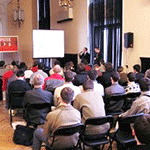 New proposals to cut the number of publicly funded third-level colleges in Ireland from 39 to 24 and eventually to 15 have recently been publicised. Supporters of the plans state the mergers will bring greater efficiency and improve quality. In the biggest shake up of universities and technology institutes for decades, colleges will pool their resources and try to reduce duplication of courses and administration.
New proposals to cut the number of publicly funded third-level colleges in Ireland from 39 to 24 and eventually to 15 have recently been publicised. Supporters of the plans state the mergers will bring greater efficiency and improve quality. In the biggest shake up of universities and technology institutes for decades, colleges will pool their resources and try to reduce duplication of courses and administration.
Proposals
Instead of separate human resource departments and payroll systems, the merged colleges would have a streamlined single system for functions of this type. Critics are sceptical and say the plans for these “super colleges” are always shifting and remain inconsistent. The sector has been buried under many different reports, recommendations, and plans.
There have of course been rumours and proposals before and a year ago, there were plans for two institutions. One merger was to result in a Border Midlands West (BMW) University covering Louth to Letterkenny and another the Technological University of Munster. These plans however, were cast out.
An expensive report commissioned by the Higher Education Authority resulted in a Dutch academic finding for a merger of UCD and Trinity. This proposal was not to popular taste and was discarded.
The continual shift and change of plan for these mergers is like trying to hook a duck at a fairground sideshow with the colleges bobbing this way and that. In this latest proposal, publicly funded third-level colleges throughout the country would be cut at first from 39 to 24 and then to a final 15.
The current plans include:
- The merger of three technology institutes in Dublin namely DIT, Tallaght, and Blanchardstown.
- ITs in Sligo, Letterkenny and Galway would merge
- ITs in Carlow and Waterford ITs would come together with a view to becoming a technological university.
Collaboration between ITs and geographically close universities would be encouraged and Teacher-training colleges would be part of a merger with universities.
How Will The Merger Plans Work?
If two ITs merge that offer similar courses, does this mean one of the courses will be discontinued and the students and lecturers moved to another campus?
The Irish Federation of University Teachers (IFUT) thinks this is possible and is concerned that students and lecturers will have to move many miles as part of this policy bringing further issues.
Many students will have additional travelling time, costs to study, and may need to avail of grants for living away from home adding pressure to already stretched grant budgets.
With mergers of this kind, lessons need to be learned from the debacle of SUSI where a centralised system introduced for efficiency resulted in chaos. It was unable to perform the function it was designed for leaving many students without any means of grant support for weeks and months.
Depending on how the mergers are played out, demand for courses could result in similar or duplicate courses remaining at each physical location. More specialised courses will be centralised at one location which makes sense as this concentration is a component of building centres of excellence so that is one benefit of merging institutions.
Merger in Practice
The Institutes of Technology in Limerick and Tipperary hasve already amalgamated and so far, the change has not been as drastic as expected for students and lecturers.
The new institute encompasses four campuses – the art college in Limerick city, the main LIT campus and the Tipperary campuses in Clonmel and Thurles. The result is an increase from 400 to 800 students on the Tipperary campuses, a reduction in staff numbers from 105 to 90 and cost savings of €3m. The campuses offer the vast majority of its previous programme of courses.
Business courses are still spread over three campuses in Limerick, Thurles, and Clonmel but the specialist areas of taxation, accountancy, law, and finance are based in Limerick.
Despite teething troubles, the merger worked well and student services have improved. Financial, computer and human resource departments were centralised with some staff redeployed.
There are issues associated with remote campuses and the merged institute has separate sports teams, because it would not be possible to centralise training.
Whether some of the institutes of technology become technological universities post merger will depend on fulfilling certain academic criteria. For example to qualify as a technology university, 45% of teaching staff will have to have doctorates.
The Network for Irish Educational Standards warns the recent proposals from the Higher Education Authority are structural changes with little to do with improving quality.
Author:
Denise Colebrooke